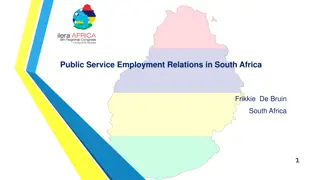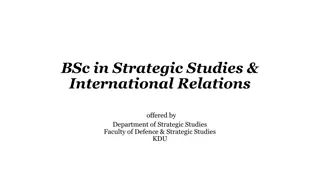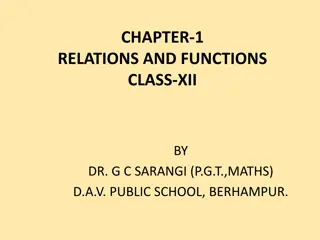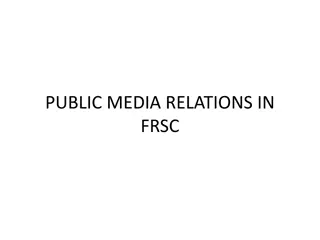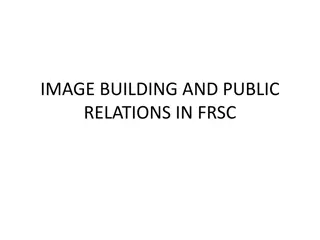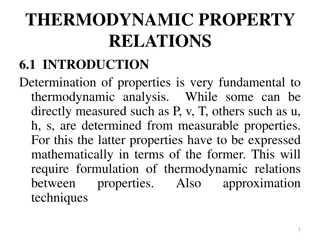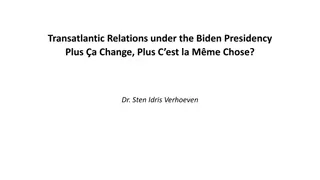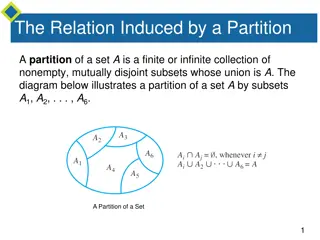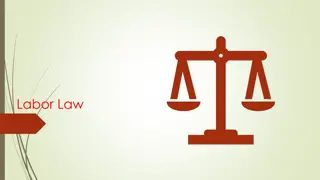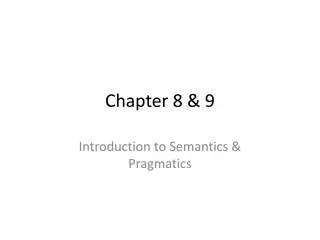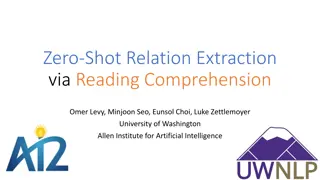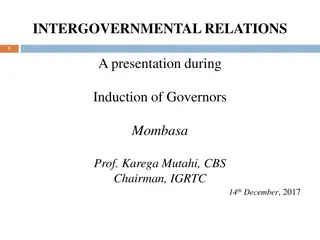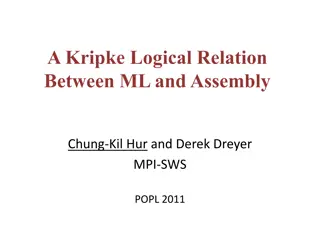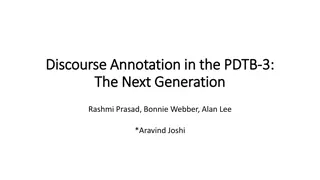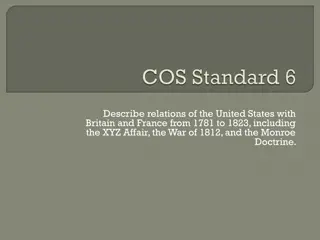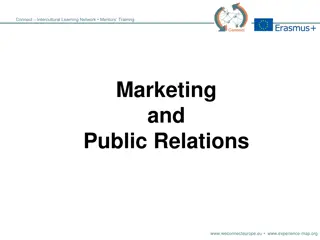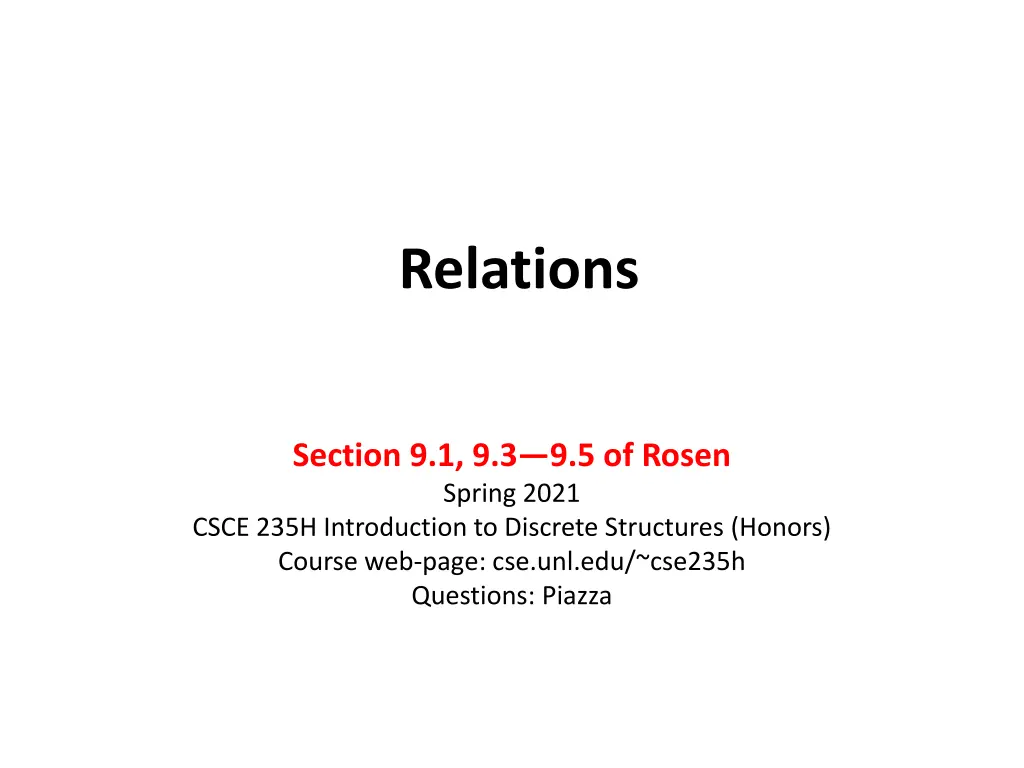
Understanding Relations in Discrete Structures
Explore the fundamental concepts of relations in discrete structures, including definitions, representations, properties, and examples. Learn about reflexive, symmetric, transitive, antisymmetric, and asymmetric properties of relations on sets. Dive into practical examples and graphical representations to enhance your comprehension.
Download Presentation

Please find below an Image/Link to download the presentation.
The content on the website is provided AS IS for your information and personal use only. It may not be sold, licensed, or shared on other websites without obtaining consent from the author. If you encounter any issues during the download, it is possible that the publisher has removed the file from their server.
You are allowed to download the files provided on this website for personal or commercial use, subject to the condition that they are used lawfully. All files are the property of their respective owners.
The content on the website is provided AS IS for your information and personal use only. It may not be sold, licensed, or shared on other websites without obtaining consent from the author.
E N D
Presentation Transcript
Relations Section 9.1, 9.3 9.5 of Rosen Spring 2021 CSCE 235H Introduction to Discrete Structures (Honors) Course web-page: cse.unl.edu/~cse235h Questions: Piazza
Outline Relation: Definition, representation, relation on a set Properties Reflexivity, symmetry, antisymmetric, irreflexive, asymmetric Combining relations , , \, composite of relations Representing relations 0-1 matrices, directed graphs Closure of relations Reflexive closure, diagonal relation, Warshall s Algorithm, Equivalence relations: Equivalence class, partitions, 2 CSCE 235 Relations
Introduction A relation between elements of two sets is a subset of their Cartesian products (set of all ordered pairs Definition: A binary relation from a set A to a set B is a subset R A B ={ (a,b) | a A, b B } Relation versus function In a relation, each a A can map to multiple elements in B Relations are more general than functions When (a,b) R, we say that a is related to b. Notation: aRb, aRb $aRb$, $a\notR b$ 3 CSCE 235 Relations
Relations: Representation To represent a relation, we can enumerate every element of R Example Let A={a1,a2,a3,a4,a5} and B={b1,b2,b3} Let R be a relation from A to B defined as follows R={(a1,b1),(a1,b2),(a1,b3), (a2,b1),(a3,b1),(a3,b2),(a3,b3),(a5,b1)} We can represent this relation graphically A B a1 a2 a3 a4 a5 b1 b2 b3 Graphical representation Bipartite Directed Graph 4 CSCE 235 Relations
Relations on a Set Definition: A relation on the set A is a relation from A to A and is a subset of A A Example The following are binary relations on N R1={ (a,b) | a b } R2={ (a,b) | a,b N, a/b Z } R3={ (a,b) | a,b N, a-b=2 } Question For each of the above relations, give some examples of ordered pairs (a,b) N2 that are not in the relation 5 CSCE 235 Relations
Properties We will study several properties of relations Reflexive Symmetric Transitive Antisymmetric Asymmetric Alert: Those properties are defined for only relations on a set 6 CSCE 235 Relations
Properties: Reflexivity In a relation on a set, if all ordered pairs (a,a) for every a A appears in the relation, R is called reflexive Definition: A relation R on a set A is called reflexive iff a A (a,a) R 7 CSCE 235 Relations
Reflexivity: Examples Recall the relations below, which is reflexive? R1={ (a,b) | a b } R2={ (a,b) | a,b N, a/b Z } R3={ (a,b) | a,b N, a-b=2 } R1 is reflexive since for every a N, a a R2 is reflexive since a/a=1 is an integer R3 is not reflexive since a-a=0 for every a N 8 CSCE 235 Relations
Properties: Symmetry Definitions A relation R on a set A is called symmetric if a,b A ( (b,a) R (a,b) R ) A relation R on a set A is called antisymmetric if a,b A [ (a,b) R (b,a) R a=b] 9 CSCE 235 Relations
Symmetry versus Antisymmetry In a symmetric relation aRb bRa In an antisymmetric relation, if we have aRb and bRa hold only when a=b An antisymmetric relation is not necessarily a reflexive relation: it may be reflexive or not A relation can be both symmetric and antisymmetric or neither or have one property but not the other 10 CSCE 235 Relations
Symmetric Relations: Example Consider R={(x,y) R2|x2+y2=1}, is R Reflexive? Symmetric? Antisymmetric? R is not reflexive since for example (2,2) R2 R is symmetric because x,y R, xRy x2+y2=1 y2+x2=1 yRx R is not antisymmetric because (1/3, 8/3) R and ( 8/3,1/3) R but 1/3 8/3 11 CSCE 235 Relations
Properties: Transitivity Definition: A relation R on a set A is called transitive if whenever (a,b) R and (b,c) R then (a,c) R for all a,b,c A a,b,c A ((aRb) (bRc)) aRc 12 CSCE 235 Relations
Transitivity: Examples (1) Is the relation R={(x,y) R2| x y} transitive? Yes, it is transitive because xRy and yRz x y and y z x z xRz Is the relation R={(a,b),(b,a),(a,a)} transitive? No, it is not transitive because bRa and aRb but bRb 13 CSCE 235 Relations
Transitivity: Examples (2) Is the relation {(a,b) | a is an ancestor of b} transitive? Yes, it is transitive because aRb and bRc a is an ancestor of b and b is an ancestor of c a is an ancestor of c aRc Is the relation {(x,y) R2| x2 y} transitive? No, it is not transitive because 2R4 and 4R10 but 2R10 14 CSCE 235 Relations
More Properties Definitions A relation on a set A is irreflexive iff a A (a,a) R A relation on a set A is asymmetric iff a,b A ( (a,b) R (b,a) R ) Lemma: A relation R on a set A is asymmetric iff R is irreflexive and R is antisymmetric Alert A relation that is not symmetric is not necessarily asymmetric 15 CSCE 235 Relations
Outline Relation: Definition, representation, relation on a set Properties Reflexivity, symmetry, antisymmetric, irreflexive, asymmetric Combining relations , , \, composite of relations Representing relations 0-1 matrices, directed graphs Closure of relations Reflexive closure, diagonal relation, Warshall s Algorithm, Equivalence relations: Equivalence class, partitions, 16 CSCE 235 Relations
Combining Relations Relations are simply sets (of ordered pairs); subsets of the Cartesian product of two sets Therefore, in order to combine relations to create new relations, it makes sense to use the usual set operations Intersection (R1 R2) Union (R1 R2) Set difference (R1\R2) Sometimes, combining relations endows them with the properties previously discussed. For example, two relations may be not transitive, but their union may be 17 CSCE 235 Relations
Combining Relations: Example Let A={1,2,3,4} B={1,2,3,4} R1={(1,2),(1,3),(1,4),(2,2),(3,4),(4,1),(4,2)} R2={(1,1),(1,2),(1,3),(2,3)} Let R1 R2= R1 R2 = R1 \ R2 = R2 \ R1 = 18 CSCE 235 Relations
Composite of Relations Definition: Let R1 be a relation from the set A to B and R2 be a relation from B to C, i.e. R1 A B and R2 B C the composite of R1 and R2 is the relation consisting of ordered pairs (a,c) where a A, c C and for which there exists an element b B such that (a,b) R1 and (b,c) R2. We denote the composite of R1 and R2 by R2 R1 19 CSCE 235 Relations
Powers of Relations Using the composite way of combining relations (similar to function composition) allows us to recursively define power of a relation R on a set A Definition: Let R be a relation on A. The powers Rn, n=1,2,3, , are defined recursively by R1 = R Rn+1 = Rn R 20 CSCE 235 Relations
Powers of Relations: Example Consider R={(1,1),(2,1),(3,2),(4,3)} R2= R3= R4= Note that Rn=R3 for n=4,5,6, 21 CSCE 235 Relations
Powers of Relations & Transitivity The powers of relations give us a nice characterization of transitivity Theorem: A relation R is transitive if and only if Rn R for n=1,2,3, 22 CSCE 235 Relations
Outline Relation: Definition, representation, relation on a set Properties Reflexivity, symmetry, antisymmetric, irreflexive, asymmetric Combining relations , , \, composite of relations Representing relations 0-1 matrices, directed graphs Closure of relations Reflexive closure, diagonal relation, Warshall s Algorithm, Equivalence relations: Equivalence class, partitions, 23 CSCE 235 Relations
Representing Relations We have seen one way to graphically represent a function/relation between two (different) sets: Specifically as a directed graph with arrows between nodes that are related We will look at two alternative ways to represent relations 0-1 matrices (bit matrices) Directed graphs 24 CSCE 235 Relations
0-1 Matrices (1) A 0-1 matrix is a matrix whose entries are 0 or 1 Let R be a relation from A={a1,a2, ,an} and B={b1,b2, ,bn} Let s impose an ordering on the elements in each set. Although this ordering is arbitrary, it is important that it remain consistent. That is, once we fix an ordering, we have to stick to it. When A=B, R is a relation on A and we choose the same ordering in the two dimensions of the matrix 25 CSCE 235 Relations
0-1 Matrix (2) The relation R can be represented by a (n m) sized 0-1 matrix MR=[mi,j] as follows 1 if (ai,bi) R mi,j = 0 if (ai,bi) R Intuitively, the (i,j)-th entry if 1 if and only if ai A is related to bi B 26 CSCE 235 Relations
0-1 Matrix (3) An important note: the choice of row-major or column-major form is important. The (i,j)th entry refers to the i-th row &the j-th column. The size, (n m), refers to the fact that MR has n rows and m columns Though the choice is arbitrary, switching between row-major and column-major is a bad idea, because when A B, the Cartesian Product A B B A In matrix terms, the transpose, (MR)T does not give the same relation. This point is moot for A=B. 27 CSCE 235 Relations
0-1 Matrix (4) B b1 b2 b3 b4 a1 0 0 1 0 a2 1 1 1 1 A a3 0 0 1 1 a4 1 0 1 1 28 CSCE 235 Relations
Matrix Representation: Example Consider again the example A={a1,a2,a3,a4,a5} and B={b1,b2,b3} Let R be a relation from A to B as follows: R={(a1,b1),(a1,b2),(a1,b3),(a3,b1),(a3,b2),(a3,b3),(a5,b1)} Give MR What is the size of the matrix? 29 CSCE 235 Relations
Using the Matrix Representation (1) A 0-1 matrix representation makes it very easy to check whether or not a relation is Reflexive Symmetric Antisymmetric Reflexivity For R to be reflexive, a (a,a) R In MR, R is reflexive iff mi,i=1 for i=1,2, ,n We check only the diagonal 30 CSCE 235 Relations
Using the Matrix Representation (2) Symmetry R is symmetric iff for all pairs (a,b) aRb bRa In MR, this is equivalent to mi,j=mj,i for every pair i,j=1,2, ,n We check that MR=(MR)T Antisymmetry R is antisymmetric if mi,j=1 with i j, then mj,i=0 Thus, i,j=1,2, , n, i j (mi,j=0) (mj,i=0) A simpler logical equivalence is i,j=1,2, , n, i j ((mi,j=1) (mj,i=1)) 31 CSCE 235 Relations
Matrix Representation: Example Is R reflexive? Symmetric? Antisymmetric? 0 0 1 MR= 1 1 1 0 0 1 Clearly R is not reflexive: m2,2=0 It is not symmetric because m2,1=1, m1,2=0 It is however antisymmetric 32 CSCE 235 Relations
Matrix Representation: Combining Relations Combining relations is also simple: union and intersection of relations are nothing more than entry-wise Boolean opertions Union: An entry in the matrix of the union of two relations R1 R2 is 1 iff at least one of the corresponding entries in R1 or R2 is 1. Thus MR1 R2 = MR1 MR2 Intersection: An entry in the matrix of the intersection of two relations R1 R2 is 1 iff both of the corresponding entries in R1 and R2 are 1. Thus MR1 R2 = MR1 MR2 Count the number of operations 33 CSCE 235 Relations
Combining Relations: Example What is MR1 R2 and MR1 R2? 1 0 1 0 0 0 MR1 = MR2 = 0 1 1 1 1 1 1 1 0 0 1 1 1 0 1 0 0 0 MR1 R2= MR1 R2= 1 1 1 0 1 1 1 1 1 0 1 0 How does combining the relations change their properties? 34 CSCE 235 Relations
Composing Relations: Example 0-1 matrices are also useful for composing matrices. If you have not seen matrix product before, read Section 3.8 1 0 1 0 0 0 MR1 = MR2 = 0 1 1 1 1 1 1 1 0 0 1 1 0 1 1 MR2 R1=MR1. MR2= 1 1 1 1 1 1 35 CSCE 235 Relations
Composite Relations: Rn Remember that recursively composing a relation Rn R for n=1,2,3, gives a nice characterization of transitivity Theorem: A relation R is transitive if and only if Rn R for n=1,2,3, We will use this idea and the composition by matrix multiplication to build the Warshall (a.k.a. Roy-Warshall) algorithm, which computed the transitive closure (discussed in the next section) 36 CSCE 235 Relations
Directed Graphs Representation (1) We will study graphs in details towards the end of the semester We briefly introduce them here to use them to represent relations We have already seen directed graphs to represent functions and relations (between two sets). Those are special graphs, called bipartite directed graphs For a relation on a set A, it makes more sense to use a general directed graph rather than having two copies of the same set A 37 CSCE 235 Relations
Definition: Directed Graphs (2) Definition: A G graph consists of A set V of vertices (or nodes), and A set E of edges (or arcs) We note: G=(V,E) Definition: A directed G graph (digraph) consists of A set V of vertices (or nodes), and A set E of edges of ordered pairs of elements of V (of vertices) 38 CSCE 235 Relations
Directed Graphs Representation (2) Example: Let A={a1,a2,a3,a4} Let R be a relation on A defined as follows R={(a1,a2),(a1,a3),(a1,a4),(a2,a3),(a2,a4),(a3,a1),(a3,a4), (a4,a3),(a4,a4)} Draw the digraph representing this relation (see white board) 39 CSCE 235 Relations
Using the Digraphs Representation (1) A directed graph offers some insight into the properties of a relation Reflexivity: In a digraph, the represented relation is reflexive iff every vertex has a self loop Symmetry: In a digraph, the represented relation is symmetric iff for every directed edge from a vertex x to a vertex y there is also an edge from y to x 40 CSCE 235 Relations
Using the Digraphs Representation (2) Antisymmetry: A represented relation is antisymmetric iff there is never a back edge for any directed edges between two distinct vertices Transitivity: A digraph is transitive if for every pair of directed edges (x,y) and (y,z) there is also a directed edge (x,z) This may be harder to visually verify in more complex graphs 41 CSCE 235 Relations
Outline Relation: Definition, representation, relation on a set Properties Reflexivity, symmetry, antisymmetric, irreflexive, asymmetric Combining relations , , \, composite of relations Representing relations 0-1 matrices, directed graphs Closure of relations Reflexive closure, diagonal relation, Warshall s Algorithm, Equivalence relations: Equivalence class, partitions, 42 CSCE 235 Relations
Closures: Definitions If a given relation R is not reflexive (or symmetric, antisymmetric, transitive) How can we transform it into a relation R that is? Example: Let R={(1,2),(2,1),(2,2),(3,1),(3,3)} How can we make it reflexive? In general we would like to change the relation as little as possible To make R reflexive, we simply add (1,1) to the set Inducing a property on a relation is called its closure. Above, R =R {(1,1)} is called the reflexive closure 43 CSCE 235 Relations
Reflexive Closure In general, the reflexive closure of a relation R on A is R where ={ (a,a) | a A} is the diagonal relation on A Question: How can we compute the diagonal relation using 0-1 matrix representation? Digraph representation? 44 CSCE 235 Relations
Symmetric Closure Similarly, we can create the symmetric closure using the inverse of the relation R. The symmetric closer is, R R where R ={ (b,a) | (a,b) R } Question: How can we compute the symmetric closure using 0-1 matrix representation? Digraph representation? 45 CSCE 235 Relations
Transitive Closure To compute the transitive closure we use the theorem Theorem: A relation R is transitive if and only if Rn R for n=1,2,3, Thus, if we compute Rk such that Rk Rnfor all n k, then Rk is the transitive closure The Warshall s Algorithm allows us to do this efficiently Note: Your textbook gives much greater details in terms of graphs and connectivity relations. It is good to read this material, but it is based on material that we have not yet seen. 46 CSCE 235 Relations
Warshalls Algorithm: Key Ideas In any set A with |A|=n, any transitive relation will be built from a sequence of relations that has a length of at most n. Why? Consider the case where the relation R on A has the ordered pairs (a1,a2),(a2,a3), ,(an-1,an). Then, (a1,an) must be in R for R to be transitive Thus, by the previous theorem, it suffices to compute (at most) Rn Recall that Rk=R Rk-1is computed using a bit-matrix product The above gives us a natural algorithm for computing the transitive closure: the Warshall s Algorithm 47 CSCE 235 Relations
Warshalls Algorithm Input: An (n n) 0-1 matrix MR representing a relation R on A, |A|=n Output: An (n n) 0-1 matrix W representing the transitive closure of R on A 1. W MR 2. FOR k=1, , n DO 3. FOR i=1, ,n DO 4. FOR j=1, ,n DO 5. wi,j wi.j (wi,k wk,j) 6. END 7. END 8. END 9. RETURN W 48 CSCE 235 Relations
Warshalls Algorithm: Example Compute the transitive closure of The relation R={(1,1),(1,2),(1,4),(2,2),(2,3),(3,1), (3,4),(4,1),(4,4)} On the set A={1,2,3,4} 49 CSCE 235 Relations
Warshall Algorithm: Mechanically 0 1 1 1 1 0 1 1 1 1 50 CSCE 235 Relations


